





Candytuft are a group of low plants found mostly in southern Europe. They include both annuals and perennials which may be grown in mild to cold regions. While the flowers are white to purple-tinted, they are often highly fragrant. If you are not familiar with these plants, read-on!
The genus Iberis, commonly known as candytuft, consists of about 30 species of low herbaceous plants native from southern Europe to western Asia. The Latin name comes from Iberia, the peninsula which includes Spain and Portugal, home to the greatest diversity of candytuft. Iberis are members of the mustard family, Brassicaceae. Typical of that family, individual flowers consist of 4 petals, but those of Iberis are quite distinct having 2 smaller inner petals and 2 larger outer ones. White is the most common flower colour but some are available in shades of pink, mauve, lilac and purple. Many are delightfully fragrant.
In the wild, Iberis grow in sunny, rather dry, rocky areas mostly on limestone derived rock. In the garden they will tolerate more acidic soil but perform better if the growing area is liberally dusted with lime. They often grow better on poorer soils, remaining stockier with tougher foliage than if grown in organically-rich soils.
For simplicity, the genus can be divided into two main groups: the annual species and the perennials. The annual species are derived from two species; I. umbellata (the most common) and I. amara. There are several named selections of the annual species, available in a wider range of colours than the perennial types. The annual species grow from 15 to 50 cm and are grown as bedding plants, cut-flowers and winter pot plants. 'Fairy Mix' and 'Fantasia Mix' are among the most popular. They prefer full sun and grow quite quickly from seed. Late winter-early spring-sown seed will bloom throughout May to July at which stage they become rather leggy and thin and are best replaced with summer-blooming annuals. Alternatively, you may sow them in succession to provide blooms all summer. In mild winter regions, they are often grown as winter-blooming annuals. As a rule, they dislike transplanting so sow them in situ. These annual species are the most fragrant of the genus. The one drawback with the annual types is that they can be prolific self-seeders and start popping up here and there in the garden or neighboring waste places.
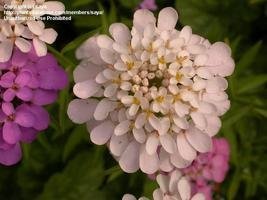
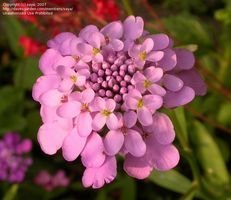
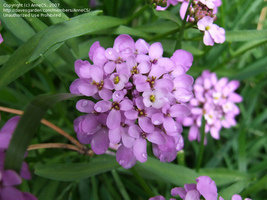
Above shows some of the colours available among selections of I. umbellata.
The perennial species are often available as small potted plants in 3- or 4-inch pots. They are easily grown from seed. Most germinate without a stratification period but if germination does not occur within a couple of weeks, place the pots in a fridge for 3 weeks to simulate a winter. They may also be grown from cuttings in July-August.
Perennial types are either rosette-forming or more commonly, somewhat shrubby, growing 15 to 30 cm. They have dark green, usually evergreen, somewhat leathery to fleshy foliage. Most of the species are only hardy to zone 6 or 7 but a couple can be grown in zone 3. By far the most popular and hardiest is the evergreen candytuft, I. sempervirens. This species is also the largest in spread with old plants reaching 5 feet of more across! This species, along with most of the perennial types, are ideal for rock gardens, rock walls or border edging. There are many named selections of evergreen candytuft which differ in flower size and plant form and heights, but all have snow-white blooms in spring to early summer depending on your location. Iberis saxatilis is very similar but only reaches 15 cm while I. sayana and I. spathulata are also look-alikes that are nearly prostrate. Iberis spathulata has lilac-tinted to pink blossoms. These latter species are also rated for zone 3. In mild areas (zone 7 and warmer) you can try I. semperflorens. This winter-blooming species appears like a giant version of the evergreen candytuft, reaching to 80 cm. Also suited to warmer regions is I. gibraltarica with pink-tinted flowers (to 30 cm) and I. pruitii (under 15 cm) with lilac-tinted flowers. These last two can tolerate temperatures down to 5 F if they are kept on the dry side.
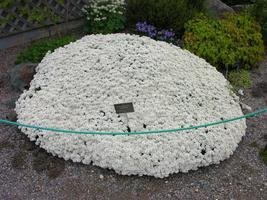
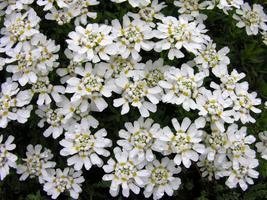
The established plant of I. sempervirens on the right is nearly 5 feet across! To the right is a close-up of the flower.
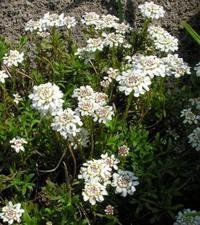
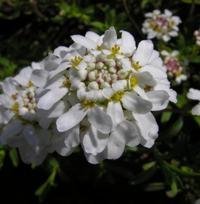
Details of I. sayana
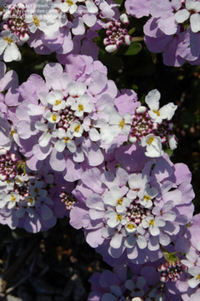
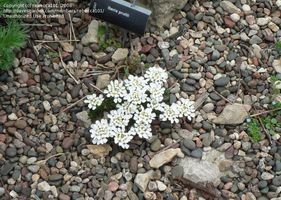
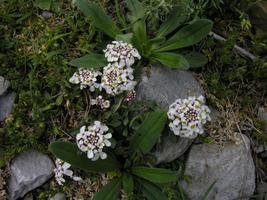
Details of I. gibraltarica (left), I. pruitii (middle) and I. spathulata (right).
So whether you prefer to grow annuals or perennials, live in cold regions or mild, there are candytufts that are suitable for your garden. If you don't grow them, try them this year!
I would like to thank the following people for the sue of their pictures: AnneCS (purple I. umbellata), growin (I. gibraltarica), rebecca101 (I. pruitii) and saya (lilac and pale pink I. umbellata).
Copyright © www.100flowers.win Botanic Garden All Rights Reserved